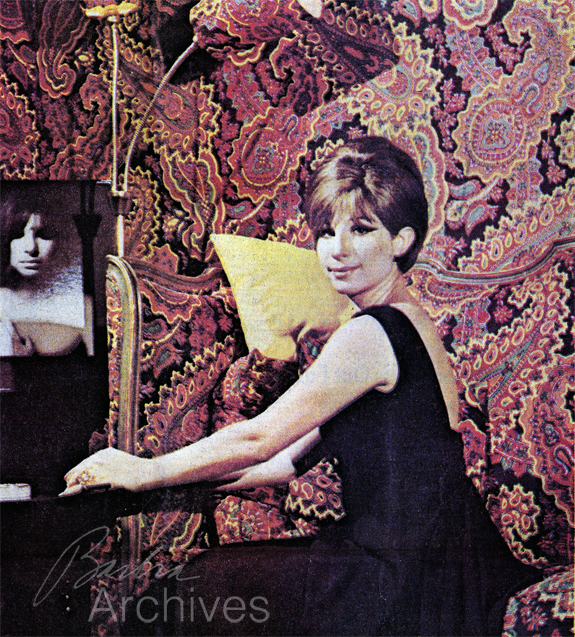Sunday Bulletin
April 25, 1965
The Curtain's Always Up For Barbra
by Robert J. Williams
LEGEND HAS IT that performers enter the golden gate to stardom when their names go up in lights on a marquee for the first time.
Barbra Streisand's name has blazed on Broadway for more than a year, fulfilling the self-proclaimed destiny she was certain was to be her's, as far back as she can remember.
But she will tell you that proof more positive than the lights, than the rave reviews, than the crowds that await her exit at the stage door of New York's Winter Garden Theater after her every performance of the musical "Funny Girl," are the skin-piercing thrusts which, inevitably, bob up in stardom's backwash.
One such came recently, while Barbra was rehearsing for her first TV special, which will be aired this week. It came from the usual source—a Broadway columnist who reported that Miss Streisand had barred the public from the rehearsals. He must have known, as does everyone with the most rudimentary knowledge of show business, that this is standard procedure, Barbra notes.
Yes, it had hurt. Barbra had brought up the subject, not her interviewer. Perhaps, during the years when Miss Streisand was forecasting her stardom, she had not thought about accompanying unpleasantness, or pretended not to.
But she obviously had looked ahead to its privileges, at a time when most of today's Barbra Streisand cultists figured the newspapers were misspelling the first name of this then obscure singer.
AT 23, MISS-STREISAND is spectacularly aware of the Streisand image she has created—the girl who has enveloped herself in the aura of the kook. It is part of her act, cannily played and strangely suited to one who can kindle, at times, the mirage of great beauty although not naturally endowed with it; to one whose voice flashes high voltage in notes whispered or shouted.
All this you know before you visit Miss Streisand, from an interview (if you want to call it that) in 1962 when she wasn't, a star, and from having followed her career closely.
When you enter the Winter Garden, where Miss Streisand has been starring as Fanny Brice in "Funny Girl" since March of 1964, the theater is dark and silent; the matinee has just ended and the evening performance is some three hours off.
You go up a flight and a half of backstage stairs to Barbra's dressing suite, and when you are let into the parlor, Miss Streisand's concept of dramatizing her stardom comes across like a 76-trombone salvo.
Subconsciously, you expect something bizarre, but not the explosion in a kaleidoscope factory that blisters your eyeballs.
The walls are papered with a paisley pattern—the softest hue a shrieking red—printed on a black background. A Victorian sofa with high back and curving arms is upholstered in the same pattern; so are the shades of a two-reflector modern lamp.
The frames of screens across one wall are black, with cloth panels of bright yellow suspended from the center is silk. The ceiling is black, and there's an old-fashioned chandelier with drop prisms. If you want to rest your eyes without looking up or closing them, you can focus on one of the two chairs in the room. They're upholstered in plain black. Or the spinet. That's black, too.
YOU SENSE that Miss Streisand expects you to comment on the wallpaper, and you do, after the hellos have been exchanged.
"Where did I get that crazy paper?" she repeats your question.
"I've been decorating my apartment for two years, and I know every wallpaper in the city of New York. It's so crazy I never could live with it at home."
You are relieved to hear that.
Miss Streisand knows why you're there; the visit ties in with the TV special she'll star in this Wednesday from 9 to 10 P. M. on CBS (Channel 10). But she doesn't remember (and you don't expect her to), that there had been that previous meeting, back in December, 1962, during which she had proclaimed that stardom for her was "inevitable." (She was to say the same thing to all interviewers.)
That had taken place, you remind her, in a quick-lunch restaurant on W. 52d st. You recall, but you don't tell her, that she had no trouble convincing you then that she bought her clothes in charity thrift shops on Second Avenue; that her getup was part of the attention-getting kook act she had been putting on. Those who saw her on the Johnny Carson show in those days will remember this masquerade. It was during one of those appearances that she sang, for the first time on network TV, her slow-tempo arrangement of "Happy Days Are Here Again," the electrifying interpretation of this Depression-born song that was to seed the Barbra Streisand legend.
BY THIS TIME, Barbra has settled herself an her crazy paisley sofa. She is wearing a plain but elegant toe-length, wine-colored dressing robe with half-sleeves, trimmed at the neck and sleeves with soft ruffles of the same wool-like material.
During the interview, she will occasionally recline her head on a square cushion covered in the same bright yellow material as the screen panels. Her carefully groomed brown hair, her grey eyes, the yellow pillow, the wine-colored robe, set against that wild back- ground . . . you think to yourself: "This girl leaves nothing to accident."
As you chat, you find out how true this is.
But first, you want to know how the creature comforts and fame, harvested from four smash record albums and Broadway stardom, have affected this most distinctive vibrant young songstress of her generation.
"It hasn't changed me," says Barbra, "but people think I have changed. No, I haven't changed — not more, that is, than everyone does in growing up.
"The big change is in how other people treat you. For instance, I can't ask how much things cost, now that they know I have money. But I must ask. Life can become mushy if you don't evaluate things sometimes."
BARBRA DOES a lot of evaluating. She says she doesn't like to be called a star. "I never think of myself as a star and I don't want people to envy me as one, but for what my talents are.
"Once you get to a certain level, people try to knock you down. It hurts. Like the other day . . ." and she told about the columnist who wrote about her barring people from rehearsals.
"The average person doesn't know it, but you get hurt all the time, once you've become somebody."
You steer the talk back to Barbra's rummage shop days, and ask Miss Streisand, whose wardrobe is now designed, mostly by Bill Blass, the high-fashion whizz kid and good friend of Barbra and her husband, Elliot Gould, whether she shops at these stores now.
"I do when I get the chance, but I don't very often. Besides, I've made them too popular. They've raised their prices."
THE CONVERSATION drifted to "Funny Girl," which has been playing to standing room ever since it opened. Miss Streisand, who once said she was determined to become a star without altering the shape of her rather prominent nose, was hand-picked for the Fanny Brice role by the late comedienne's daughter, Mrs. Ray Stark. Mrs. Stark is the wife of "Funny Girl" producer Ray Stark.
Miss Streisand was asked if she gets tired of playing Fanny Brice eight times a week.
"Naturally I do. I would be lying if I said otherwise. But what saves me is that I sing the songs differently every performance. Depending on what I eat for dinner, my attitude is different, and so is every audience.
"I have learned to tell what kind of audience is out there as soon as the overture is over. If they applaud it enthusiastically, I know they'll applaud me. I have developed quite an awareness to this.
"The Wednesday matinee audience is usually the toughest. It's mostly ladies, and they come more to have a good time than to see the show. It's a little strange, all women. You need men in an audience.
"Saturday, matinee is the best audience of all. There are both men and women, and they're seeing the show at half price and you get double the laughter. When I was a kid, I always saved my money until I could afford to buy an orchestra seat at a Saturday matinee—it was the only time I could afford to sit in the orchestra."
NOTING THE SMALL piano in her dressing room, Miss Streisand was asked if she rehearses often, if she warms up, for each performance.
"I never practice singing. I do my experimenting on stage."
Well, when you've made a record, do you play it to hear yourself?
"I don't like to listen to myself sing. I've tried it, but I can't relax. I listen so critically. When I play records, they're usually by Ray Charles, or Billie Holiday (the late blues singer). They're my favorites.
We talked about Barbra's upcoming TV show, her first special she'll do for CBS under terms of a contract signed last year. It will be titled "My Name Is Barbra," and only the spelling of Barbra is original, Miss Streisand hastened to explain.
"Actually, 'My Name Is Barbara' is the title of one of five children's songs written for soprano by Leonard Bernstein. They were first sung by Jennie Tourel (the opera singer) at a concert.
"The show will be in three parts. I'll open singing against a background of a surrealistic set. Next I'll talk to the audience and do some comedy bits (a comedic fashion show filmed at Bergdorf Goodman). The final portion will be strictly concert. I'm going to do the Bernstein song with a children's woodwind quintet—that is my idea, to have the children."
Her costumes for the show were designed by Blass. And she'll wear furs by Emeric Partos, and hats by Halston, both of Bergdorf Goodman.
And what comes after "Funny Girl" closes?
"Well, I can't do another show for a while. I'd like to try the movies, but most of all, I want to travel all over the world and do concerts."
MISS STREISAND has been out of the country only once—a quickie trip to London while her husband was starring in a revival of the old Bernstein musical, "On the Town."
The Streisand-Elliot Gould romance bloomed while both were playing in "I Can Get It For You Wholesale," a musical in which Gould had a leading role (as a heel) and Barbra the "Miss Marmelstein" part that first attracted attention to her. It was her first Broadway show,"Funny, Girl," her second.
End.

